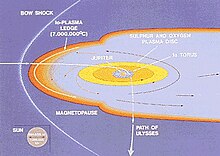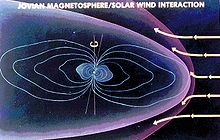







Waves is an experiment on the Juno spacecraft for studying radio and plasma waves. [1] [2] It is part of a collection of various types of instruments and experiments on the spacecraft; Waves is oriented towards understanding fields and particles in the Jupiter's magnetosphere. [2] Waves is on board the uncrewed Juno spacecraft, which was launched in 2011 and arrived at Jupiter in the summer of 2016. [1] The major focus of study for Waves is Jupiter's magnetosphere, which if could be seen from Earth would be about twice the size of a full moon. [3] The magnetosphere has a tear drop shape, and that tail extends away from the Sun by at least 5 AU (Earth-Sun distances). [3] The Waves instrument is designed to help understand the interaction between Jupiter's atmosphere, its magnetic field, its magnetosphere, and to understand Jupiter's auroras. [4] It is designed to detect radio frequencies from 50 Hz up to 40,000,000 Hz (40 MHz), [5] and magnetic fields from 50 Hz to 20,000 Hz (20 kHz). [6] It has two main sensors: a dipole antenna and a magnetic search coil. [6] The dipole antenna has two whip antennas that extend 2.8 meters (110 inches/ 9.1 feet) and are attached to the main body of the spacecraft. [6] [7] This sensor has been compared to a rabbit-ear TV antenna. [8] The search coil is overall a Mu-metal rod 15 cm (6 in) in length with a fine copper wire wound 10,000 times around it. [6] There are also two frequency receivers that each cover certain bands. [6] Data handling is done by two radiation-hardened systems on a chip. [6] The data handling units are located inside the Juno Radiation Vault. [9] Waves is allocated 410 Mbits of data per science orbit. [9]
Contents
On June 24, 2016, the Waves instrument recorded Juno passing across Jupiter's magnetic field's bow shock. [3] It took about two hours for the uncrewed spacecraft to cross this region of space. [3] On June 25, 2016, it encountered the magnetopause. [3] Juno would go on to enter Jupiter's orbit in July 2016. [3] The magnetosphere blocks the charged particles of the solar wind, with the number of solar wind particles Juno encountered dropping 100-fold when it entered the Jovian magnetosphere. [3] Before Juno entered it, it was encountering about 16 solar wind particles per cubic inch of space. [3]
There are various other antennas on Juno, including the communications antennas and the antenna for the Microwave Radiometer. [9]
Two other instruments help understand the magnetosphere of Jupiter, Jovian Auroral Distributions Experiment (JADE) and Magnetometer (MAG). [10] The JEDI instrument measures higher energy ions and electrons and JADE lower energy ones; they are complementary. [10] Another object of study is plasma generated by volcanism on the moon Io and Waves should help understand that phenomenon. [6]
A primary objective of the Juno mission is to explore the polar magnetosphere of Jupiter. While Ulysses briefly attained latitudes of ~48 degrees, this was at relatively large distances from Jupiter (~8.6 RJ). Hence, the polar magnetosphere of Jupiter is largely uncharted territory and, in particular, the auroral acceleration region has never been visited. ...
— A Wave Investigation for the Juno Mission to Jupiter [11]
One issue that came up in 2002 was when the Chandra X-ray Observatory determined with its high angular resolution that X-rays were coming from Jupiter's poles. [12] The Einstein Observatory and Germany's ROSAT previously observed X-rays from Jupiter. [12] The new results by Chandra, which took the observations during December 2000, showed X-rays coming from the magnetic north pole, but not the aurorae. [12] Roughly every 45 minutes Jupiter sends out a multi-gigawatt X-ray pulse, and this is synchronized with an emission in radio at 1 to 200 kHz. [12] The Galileo Jupiter orbiter and Ulysses solar orbiter picked up the radio emissions every 45 minutes. [12] The radio emissions were discovered before the X-rays (they have been detected since the 1950s), and there is even a citizen astronomy project organized by NASA called Radio Jove for anyone to listen to Jupiter's radio signals. [13] [14] Kilometric radio radiation was not detected until the Voyager flybys of Jupiter in the late 1970s. [14] Two candidates for the source of the X-rays are particles of solar wind and particles from Io. [12]
Waves was developed at the University of Iowa, and the experiment is led by a research scientist there. [8]

